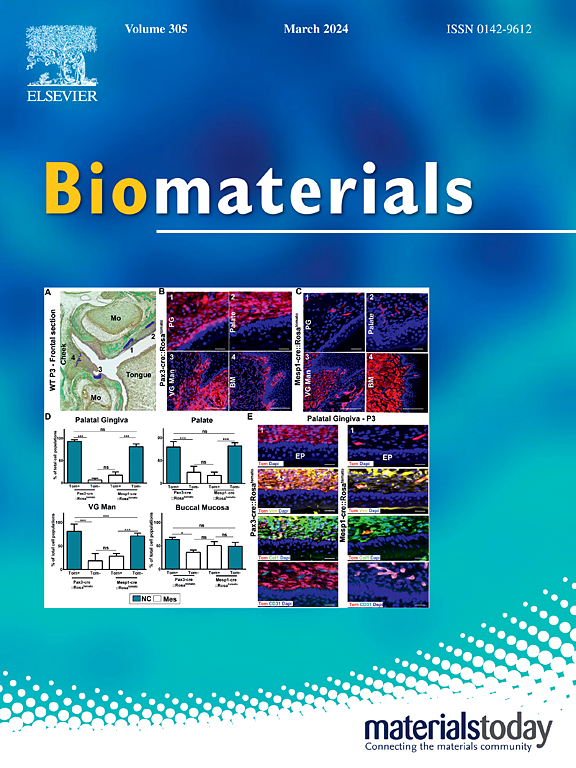A protective growth factor delivery strategy based on polyphenol-protein self-assembly to promote inflammatory bone regeneration
IF 12.8
1区 医学
Q1 ENGINEERING, BIOMEDICAL
引用次数: 0
Abstract
The efficacy of growth factor delivery-based therapies for bone tissue regeneration is frequently undermined by oxidative stress, especially under inflammatory conditions, which results in structure damage and function inactivation of growth factors. Herein, a straightforward and universal protective delivery strategy is proposed by employing the multiple physical interactions between epigallocatechin-3-gallate (EGCG) and growth factors (e.g., neuregulin-1/NRG-1) to efficiently form self-assembled particles (NE APs). NE APs provide sustained release of NRG-1 while protecting it from oxidative damage, preserving its biological functions of cell recruitment, migration, and angiogenesis. Additionally, NE APs leverage EGCG's ability to scavenge reactive oxygen species and maintain mitochondrial homeostasis, while synergistically enhancing TNF/NF-κB/JAK-STAT signaling pathways to support immune responses and osteogenic differentiation. In vivo experiments demonstrated that NE APs create a favorable microenvironment for bone regeneration through stem cell recruitment, angiogenesis, and immune modulation, effectively promoting the repair of inflammatory bone defects. This versatile protective delivery strategy, based on polyphenol and growth factor self-assembly, offers the potential to advance the application of growth factors in regenerative medicine.

基于多酚蛋白自组装的保护性生长因子递送策略促进炎性骨再生
基于生长因子递送的骨组织再生治疗的效果经常被氧化应激破坏,特别是在炎症条件下,氧化应激会导致生长因子的结构损伤和功能失活。本文提出了一种简单而普遍的保护性递送策略,即利用表没食子儿茶素-3-没食子酸酯(EGCG)和生长因子(如神经调节蛋白-1/NRG-1)之间的多重物理相互作用来有效地形成自组装颗粒(NE ap)。NE ap提供NRG-1的持续释放,同时保护其免受氧化损伤,保留其细胞募集、迁移和血管生成的生物学功能。此外,NE ap利用EGCG清除活性氧和维持线粒体稳态的能力,同时协同增强TNF/NF-κB/JAK-STAT信号通路,以支持免疫反应和成骨分化。体内实验表明,NE ap通过干细胞募集、血管生成和免疫调节为骨再生创造了有利的微环境,有效促进炎症性骨缺损的修复。这种基于多酚和生长因子自组装的多功能保护递送策略,为促进生长因子在再生医学中的应用提供了潜力。
本文章由计算机程序翻译,如有差异,请以英文原文为准。
求助全文
约1分钟内获得全文
求助全文
来源期刊

Biomaterials
工程技术-材料科学:生物材料
CiteScore
26.00
自引率
2.90%
发文量
565
审稿时长
46 days
期刊介绍:
Biomaterials is an international journal covering the science and clinical application of biomaterials. A biomaterial is now defined as a substance that has been engineered to take a form which, alone or as part of a complex system, is used to direct, by control of interactions with components of living systems, the course of any therapeutic or diagnostic procedure. It is the aim of the journal to provide a peer-reviewed forum for the publication of original papers and authoritative review and opinion papers dealing with the most important issues facing the use of biomaterials in clinical practice. The scope of the journal covers the wide range of physical, biological and chemical sciences that underpin the design of biomaterials and the clinical disciplines in which they are used. These sciences include polymer synthesis and characterization, drug and gene vector design, the biology of the host response, immunology and toxicology and self assembly at the nanoscale. Clinical applications include the therapies of medical technology and regenerative medicine in all clinical disciplines, and diagnostic systems that reply on innovative contrast and sensing agents. The journal is relevant to areas such as cancer diagnosis and therapy, implantable devices, drug delivery systems, gene vectors, bionanotechnology and tissue engineering.
 求助内容:
求助内容: 应助结果提醒方式:
应助结果提醒方式:


